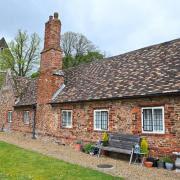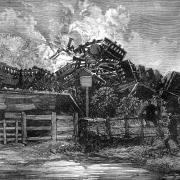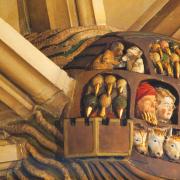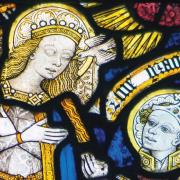For no less than 121 years the successive rectors of Little Massingham were members of one family, the Breretons – the first was the son-in-law of the patron of the living, the owner of the Little Massingham estate. A good Trollopian-era arrangement.
The second Brereton to hold the living was Joseph, a quite remarkable man who devoted much of his life to the provision and improvement of education, especially for the agricultural and middle classes, and who was the driving force behind the establishment of the Norfolk County School, an experiment perhaps doomed to failure from the start in the face of the great agricultural depression.
Joseph Brereton had not been a healthy child. Unlike his 10 siblings, he was baptised very soon after his birth, often a sign that there was doubt as to whether the baby would live. Joseph did survive but issues relating to his health seem to have influenced decisions about his own education. He was not initially sent away to school, as might have been expected of a child from his background. His education started at home, and he then attended a day school in Islington. The school was conducted on religious principles; indeed Joseph’s headmaster later became Bishop of London. It was a ‘proprietary school’ – one funded by private investors in return for dividends.

His accomplishments at university were achieved despite continuing health issues, which caused him to take breaks from his time at Oxford. On one such break he found employment as tutor to the son of a wealthy family in the West Country thus experiencing education, as a provider, for the first time. He found the role congenial, and this, combined with his experience both as a product of proprietary education and as a pupil of Thomas Arnold, whom he greatly admired, all contributed to the development of his ambition to create a new kind of school to meet what he saw as a gap in the then current provision. His concern was particularly about the farming community. He felt that farmers, often living in remote areas, were both insufficiently prosperous to afford the fees of major public schools, and too far from major towns to take advantage of good day schools.
But first, he was ordained and, after a brief spell as a curate both in Norwich, and later London, he returned to Devon, as Rector of West Buckland. Apart from education, his interests were with the agricultural community, and – in common with many parsons – the railways. He became actively involved with both – he was the founder of the Barnstaple Farmers Club and one of the moving spirits behind an extension to the Great Western Railway. Later he was to be involved with the building of the Lynn and Fakenham Railway.
While working in Devon he became very friendly with Viscount Ebrington, and his father, the 2nd Earl Fortescue, Lord Lieutenant of the county. With their support, both financial and moral, he established what was originally known as the Devon County School, which thrives today, as West Buckland School, on land donated by the Earl. Joseph was adept at acquiring the support of the support of the powerful and wealthy – his own family background helped.

Optimism, even extreme optimism, were characteristic of Joseph’s longer-term plans, several of which foundered on financial grounds. For those in Norfolk, the most important was certainly the development of the Norfolk County School. As with his work in Devon, he was able to call on the support of the great and the good for his project. Quite apart from his illustrious Devon supporters, he gained the support of Lord Leicester, who donated the site and subscribed for £1,000 worth of shares in the company established to run the school. Even Bertie, Prince of Wales and later King Edward VII – not a man noted for enthusiasm about education - donated £250 to establish a scholarship in his name.
In his plans for the school Joseph displayed his usual optimism. The original plan was to cater for 200 boarding pupils, but he decided to increase this to 300. Ten thousand pounds was raised locally to establish the school. The prospectus he produced to attract investment predicted, based on just the original 200 planned pupils, an income adequate to pay an annual dividend in the order of 5%. Since this was some 40% higher than the then current yield on Consols it probably seemed a generous risk premium.

The building of the school was completed on time, but over budget – costing £16,000, rather than the original £10,000. The opening ceremony took place on September 16 1874, when 200 guests were invited to lunch. One of those guests was my great grandfather who, in his diary recorded that it rained heavily all day, that the lunch was long and the speeches even longer. He reported that not only were the speeches over-long, but also indifferent. In fact, both the weather and the speaking were so poor, that when eventually a toast was proposed to Mr Giles, the architect of the buildings, it transpired that whether because of the rain or the speeches, he had gone home in mid ceremony!
Not an auspicious beginning, and things got worse. The overspend on building meant that the minimum number of pupils to make the school financially viable had gone up to 270. The actual number of pupils with which the school opened was just 70. Things only improved slowly – it was 1881, seven years after the school opened, that pupil numbers reached 100, and after that numbers declined so rapidly that, 10 years later, pupil numbers had fallen to just 16.
Long before this the investors had started becoming restless. A couple of years after the school opened two of the governors had described the school’s accounts as ‘illegal, informal and unintelligible’. A subsequent investigation by Price Waterhouse, the steadying influence of Mr Birkbeck from Gurney’s Bank at a special meeting called by the shareholders and the accompanying statement by Joseph, who even cited the Book of Psalms in his own defence, calmed things temporarily. Surprisingly, he left with the full support of the audience – the meeting even passed a resolution writing off his own debt of £800 to the school.
But things could clearly not continue in the same way, and in 1895 the school closed. The splendid premises remained empty for about four years, at which time they were purchased for Dr Barnardo’s by a benefactor, shipping magnate E H Watts. For over 50 years the former school operated under the Barnardo’s flag as the Watts Naval Training College. Finally, the premises were demolished in the 1950s - all that remains today is the County School Station, built to serve the school.
Joseph’s story is a sad one. Unfortunate in his timing – the great agricultural depression hit Norfolk especially hard, and major changes in education nationally with the passing of the Free Education Act in 1891, reduced both the size and the financial means of his target audience. His other enterprises, a series of schools for the education of girls and the establishment of a new college at Cambridge to provide tertiary education for the same target market also failed, leaving one asking why Woodard was so much more successful. For me, the key difference lay in the funding methods they employed. Woodard relied primarily on foundation and charity, while Joseph was firmly wedded to the proprietary basis which depended on the ability of the institution to satisfy the expectations of his shareholders – they had, after all, been asked to invest, not to donate.

It would be quite wrong to form just a negative view of him. His intentions were excellent, his energy remarkable, and his ability to cajole large sums out of wealthy patrons extraordinary. He was unfortunate at a personal level – very serious injuries in a rail accident just at a time when his normal energy and enthusiasm were most needed certainly handicapped him, though whether full fitness would have enabled him to repair the fortunes of his projects is doubtful.
In the opening paragraphs I described Joseph Brereton as ‘remarkable’. As evidence of the contemporary view of him it is worth noting that, in 1882, just as the school was beginning its toboggan ride to oblivion, and despite the distress of the original investors, a fund was set up to provide a memorial to him. Papers relating to it are held at the County Record Office where there is a handwritten list of those who subscribed. It includes the Prince of Wales, Lord Hastings, and the Gurneys. Many others wrote commending his work, - there was just one letter declining to contribute – ironically it came from Mr Lee Warner of Walsingham, who regretted his inability to contribute due to his diminished income resulting from the same agricultural depression which had been such a headwind to Joseph’s grand ambitions.
A fuller account of the story of the Norfolk County School can be found in Chris Armstrong’s book ‘Scholars, Saints and Sinners’ (Poppyland 2019).



























